This activated charcoal face soap recipe is simple enough for beginner soapmakers, yet results in an impressive bar of cleansing, yet moisturizing face soap.
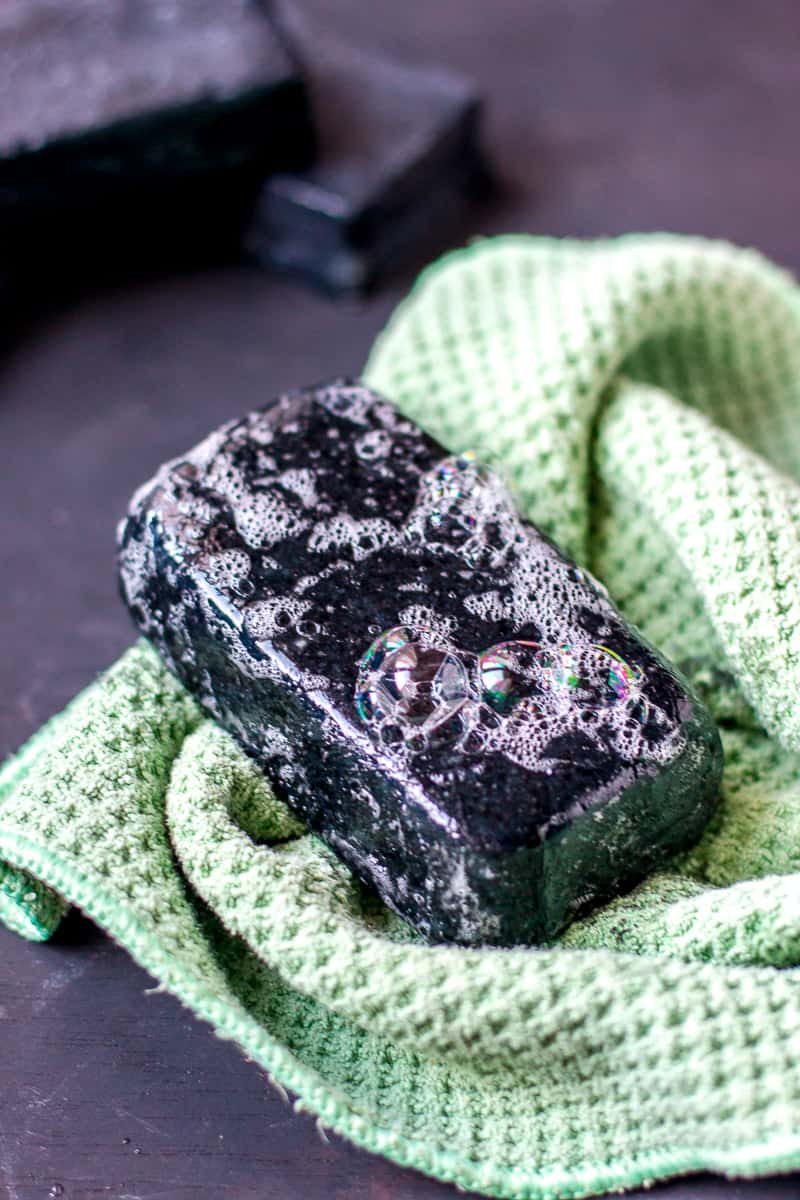
I’m really excited to share with you today’s new soap recipe. I’ve been doing more studying on the oils used in soapmaking, along with some of the other ingredients, and think that I’m getting better at developing soaps that have a good balance of cleaning, moisturizing, and lather.
Just because I’m using a few more oils and ingredients than I did in my easy beginner soap recipe doesn’t mean that this soap is difficult to make by any means. This recipe is simple to make, but looks super impressive if you want to get ahead of the game and make some bars as nice Christmas gifts.
I have to admit that I studied BEAUTYCOUNTER’s Charcoal Cleansing Bar ingredients when I was looking to formulate my own activated charcoal face soap recipe.
At the time I was one of their consultants, and wasn’t trying to copy their formula; I just used it as a bit of inspiration. There were people asking me to come up with a cheaper alternative to that specific bar, and I was curious as to what was so special about it.
Watch me make this activated charcoal face soap:
Should you buy the Beautycounter charcoal bar or make your own charcoal face soap?
Well, it all depends. If you aren’t already making your own products, and don’t have a lot of the ingredients on hand, you may not save much money, at least not in the first batch. The Beautycounter charcoal soap bar should last you at least for several months, so it really isn’t a big expense on a daily basis.
I chose to make my own activated charcoal face soap because I love making soaps to begin with. Elaborating new soap recipes has become a creative outlet for me, and I take each new recipe as a bit of a challenge. Seeing as I had most of the ingredients already, and knew I’d be able to use all of the ingredients in other recipes, it wasn’t much of an expense for me.
So, why did I study the ingredients in the Beautycounter charcoal bar?
1. While I haven’t tried it myself, I’ve heard from friends that it works really well on blackheads and breakouts, and that the soap is one of their best sellers because everybody loves it so much!
2. From what I studied when I was a consultant with them, it seemed to me that they spend a lot of time investigating their ingredients, looking for the safest yet most effective ingredients in all of their products. Knowing that, I figured that using their ingredients as a guideline would really help me formulate my own great soap.
Why haven’t I tried their Charcoal Cleansing Bar yet to compare it?
Unfortunately, Beautycounter doesn’t sell to Europe as of yet, so I have to order and send to my parents’ houses in the US whenever I want a new product. My last order of products was placed in June when I travelled to the US to pick it all up. As much as I love using those trips to stock up on new products, I try not to go overboard either. As it was, we had to pay for another suitcase on the way home this trip! 🙂
When I did buy from them, I chose products that are more difficult to make at home. A bar of soap is probably the easiest and most inexpensive product for me to try to make myself.
While I haven’t compared them myself, I was super excited to get the following comment from a reader:
You nailed the charcoal bar!! I cannot tell the difference between my boughten charcoal bars from Beautycounter and my DIY bars ( other than price) The quality of these bars are superb, you did an amazing job!! My girls’ and I are extremely grateful!! That recipe is like gold to us!!
She was wondering when I was going to try to make a copycat of the cleansing balm. 🙂
Hmmmmm- I guess I’ll have to put that on my “to-do” list.
What’s in the Beautycounter Charcoal Cleansing Bar?
Here is the list of ingredients: Sodium Rapeseedate, Sodium Cocoate, Aqua/Water/Eau, Glycerin, Charcoal Powder, Sodium Citrate, Hamamelis Virginiana (Witch Hazel) Water*, Carthamus Tinctorius (Safflower) Seed Oil*, Cocos Nucifera (Coconut) Oil*, Alcohol*, Camellia Sinensis (Green Tea) Leaf Extract*. Tocopherol.
*Organic
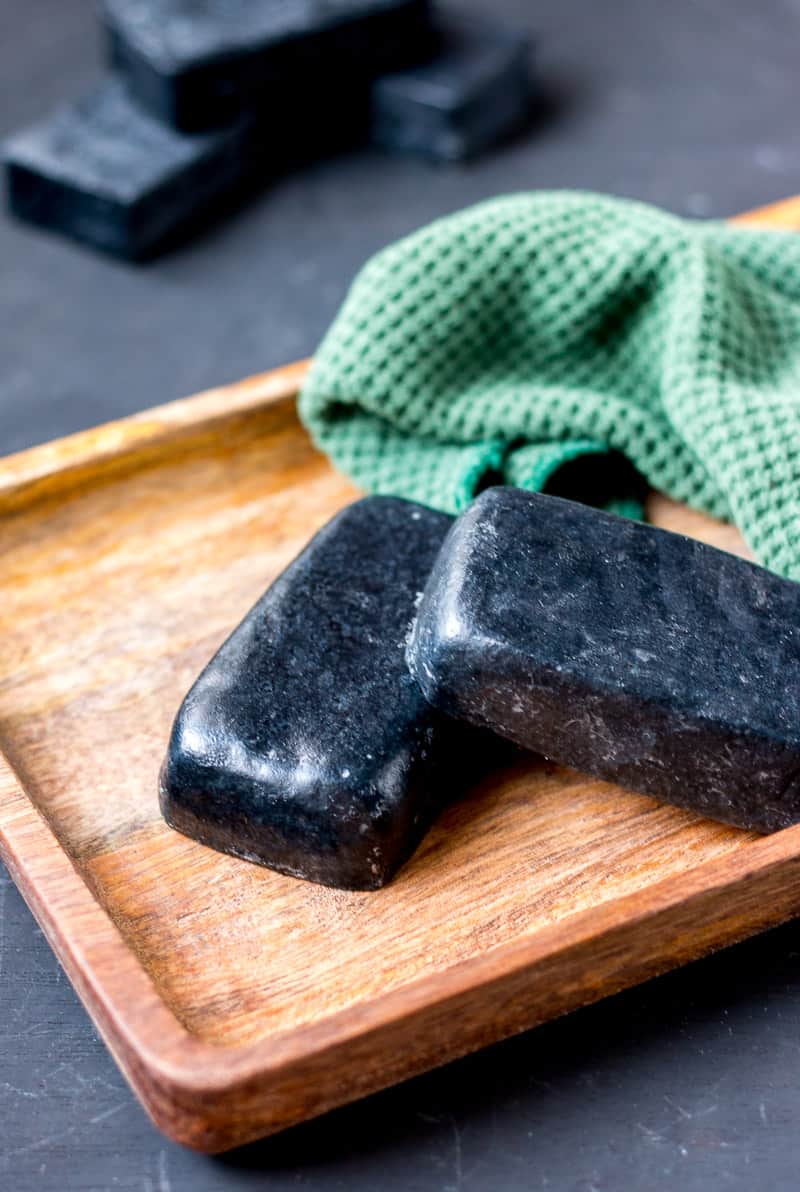
Comparing the ingredients in the charcoal face soaps…
Beginning form the top of their ingredient list, sodium rapeseedate and sodium cocoate are basically just the already saponified rapeseed and coconut oils. That means they have already been reacted with lye.
Coconut oil in soaps is great because it cleans well and adds a great, bubbly lather. I had never used rapeseed oil in soap before, though, so this was a new one for me.
I always avoided rapeseed oil in soap in the past, partly because it’s a difficult oil to find here in Spain, and partly because I had read that it could go rancid more quickly if used in large amounts in a soap. After further study, though, I read that it can a great oil to use in soap, in limited percentages, because it is moisturizing and gives a creamy lather (as opposed to the bubbly lather from the coconut oil). Plus it makes a pretty, shiny, smooth bar of soap.
Here come the first differences:
Because making a soap out of only rapeseed oil, coconut oil and safflower oil was out of my comfort zone, I decided to add some olive oil to my recipe. (Plus, olive oil is inexpensive and easy to find here in Spain.) I added olive oil for its moisturizing qualities, castor oil because it helps make the lather last longer, and shea butter because it’s high in “unsaponifiables,” leaving conditioning oils which I thought would be great for face moisturizing.
Going back to their ingredient list…
I, of course, also added water to my soap. I skipped over the glycerin, and added the charcoal powder, my version of the sodium citrate (citric acid, because sodium citrate is basically the sodium salt of citric acid), and some witch hazel.
Perhaps next time I may try substituting part of the water with glycerin as I’ve since found that it helps give a nice moisturizing quality to soaps, even when they aren’t highly superfatted. That helps give a moisturizing soap that doesn’t feel like it’s leaving a film on your skin. I really love the added glycerin in my recipes for glycerin soap, liquid castile soap, and liquid coconut oil soap.
I wasn’t sure why they would add citric acid to the soap, but after some investigation, I learned that not only does it serve to prevent oxidation of the ingredients which could lead to the “Dreaded Orange Spots,” commonly known as “DOS” in soap making forums, but it also possibly works as a chelator to help fight soap scum buildup. (Dreaded orange spots are a discoloration that can appear in soaps, especially when using certain oils or rancid fats. While it’s a mostly cosmetic problem, it can also affect the scent making the soap smell less fresh. In this case, the black coloring of the charcoal soap would hide any orange spots, but it’s still best to avoid them from forming.)
As for the witch hazel, I used a distilled witch hazel without any added alcohol. Alcohol can react with the lye, and can also affect the final outcome of the soap, so if you aren’t sure about the witch hazel you have, you can skip using it. Just make sure to replace the witch hazel with the same amount of distilled water.
Because safflower oil isn’t something I can readily find here, I decided to use olive oil, and the other oils mentioned above, instead.
Continuing down their list, I’m not sure about the addition of alcohol. I’m sure they have a great reason for adding it, but since I’m already using different ingredients and don’t know how or why to add it, I didn’t.
I did decide to go with the last two ingredients they added to their bar, though. Green Tea Leaf Extract and Tocopherol (aka. vitamin E) are great antioxidants that are not only great for your skin, but they help preserve the oils in your soap to keep them from going rancid.
Why use activated charcoal in a face soap?
Activated charcoal has become increasingly popular in beauty products lately because it is thought to absorb toxins, excess oils, and help better cleanse the skin.
One of the most common findings after using activated charcoal products is that pores become less visible and smaller, and blackheads start to disappear.
It may also help absorb excess oils in people with oily skin. Plus the black color makes a pretty slick looking black soap!
How do I like my homemade charcoal face soap?
I actually am loving this soap so far. I had planned on adding some rosemary essential oils to my soap bar, but forgot until it was too late, so my bar ended up being unscented.
Rosemary oil extract is used quite often by soapmakers as another natural additive that helps keep the oils in the soap from going rancid, and helps prevent the dreaded orange spots (DOS) I mentioned above. The extract doesn’t have much of a scent, but the essential oil itself does. Rosemary essential oil gives off a nice, natural fragrance and is a potent antioxidant for fighting off rancidity in oils.
If you don’t want to add a scent, though, you don’t really need to add much oil to help preserve your soap longer. A few drops should be enough. You could also leave it out if you wanted, like I accidentally did. 🙂
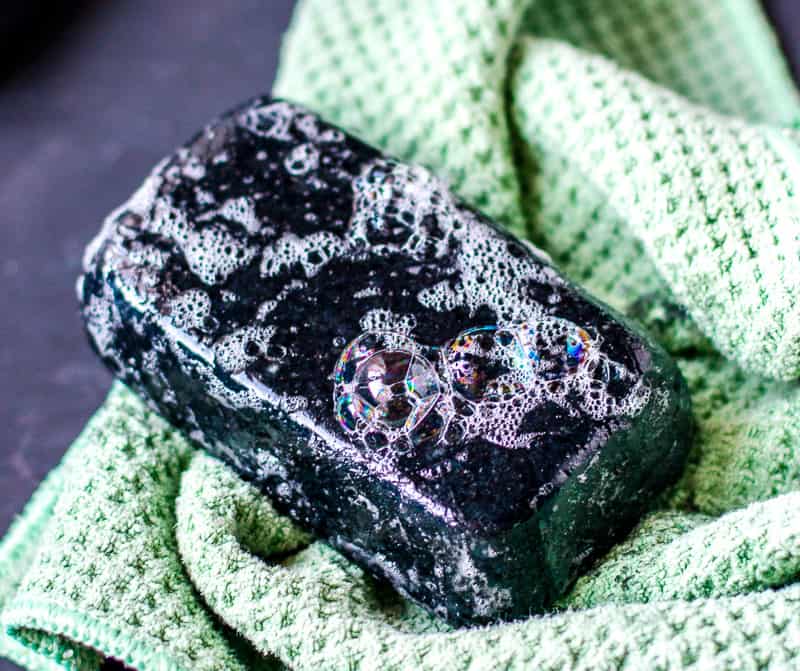
Activated Charcoal Face Soap Recipe
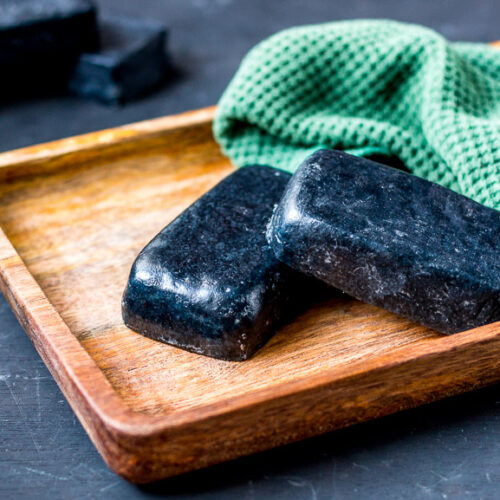
Activated Charcoal Face Soap Recipe
for an 800g mold.
Materials
- 225 g olive oil
- 125 g coconut oil (Type that solidifies below 76ºF, not fractionated.)
- 100 g rapeseed oil (If you use canola oil instead, use 69g of lye)
- 25 g castor oil
- 25 g shea butter
- 100 g distilled water
- 90 g witch hazel (distilled, no alcohol)
- 68 g lye
- 1 Tbsp. activated charcoal
- 1 tsp. green tea extract
- 1/2 tsp. citric acid
- 5 drops vitamin E
- 20 drops rosemary essential oil (optional)
Instructions
- Measure out the water in a large glass or ceramic bowl, and add the measured lye to the water (and NOT the other way around). It’s a good idea to use gloves and a mask for this part of the process, and to mix together outside, avoiding the fumes. If you haven’t made soap before, or have questions about the process, I’d suggest you check out my first post about how to make an easy, beginner soap.
- Carefully mix together the lye and water until the lye is completely dissolved. It will get cloudy at first, and will begin to warm up. Leave the mixture alone to cool in an area where it won’t be touched by other people, children, or animals. You’ll notice that the mixture becomes more transparent again as it cools off.
- Meanwhile begin to measure out and combine the olive oil, rapeseed oil, coconut oil, castor oil, and shea butter. The easiest way is to accomplish this task is to tare the empty bowl before adding the first oil and taring again between additions of the oil. (I tend to make less soap in the winter when the coconut oil is solid, but since you are measuring by weight, it doesn’t make a difference if the oil is solid or liquid when you add it.)
- Combine the oils together with a hand held blender. The solid shea butter should easily combine into the liquid oils, forming a smooth, thick liquid. If you are working in cold temperatures and are having a hard time combining all of the oils, you can slightly warm them to make the process easier.
- Add the witch hazel to the lye-water mixture and stir it together carefully.
- You can now carefully combine the water-witch hazel-lye mixture with the oil mixture. I do this by pouring the lye mixture into the oil mixture and combining slowly with a metal spoon.
- Once everything is well combined, you can begin to use a hand held blender to continue to mix together all of the ingredients. We are looking to keep blending until reaching what is called “trace,” the point in making the soap when it will begin to thicken like a mayonnaise.
- When you start to reach a light trace (a thin, runny mayonnaise consistency), begin adding in the rest of the ingredients and combine them well.
- When you have a more normal mayonnaise consistency, pour the soap into the prepared molds.
- I’ve gotten into the habit of covering the soap with plastic and covering it with a towel for the first 24 hours or so, but it’s not really necessary. Leave your soap alone in the molds to completely set before removing them.
- This soap takes longer to set than my basic beginner soap, so you will need to wait longer before unmolding your soaps. I found it possible to unfold them after a few days, but the soap was still very soft and distorted and lost details. My best looking soaps had been left in the molds for a week or so before trying to unmold them.
- Once you have removed the soaps from the molds, leave them out to air dry and further harden. Ideally, you should turn the soaps occasionally so they dry equally on all sides, and you should also wait around a month before using the soap so that it is harder and lasts longer. (If you use the soap when it’s soft, it will easily dissolve and be used up much more quickly.)
- You can now use your soap, or package it for gift giving. Enjoy!
 Español
Español
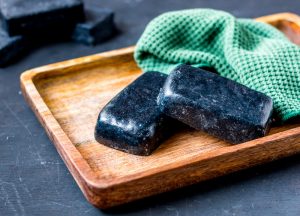
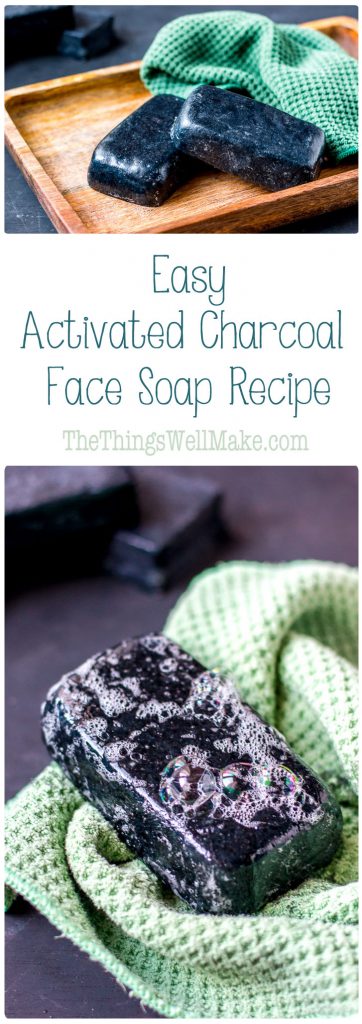
 10 Healthy, Refreshing Summer Cocktails and Mocktails
10 Healthy, Refreshing Summer Cocktails and Mocktails
Andre Robichaud
I have been making soap for 10+ years. I super fat at 5%. So therefore if charcoal (alkaline) is added, doesn’t the extra oils (acid) combine the charcoal and produce more soap? Leaving with no charcoal?
Tracy Ariza, DDS
Hi Andre,
Different charcoals can have different pH’s, but even if it is alkaline, you can’t make soap by combining any alkaline substance with oil. With soap, the triglycerides of the oil combine with the NaOH (or KOH in the case of liquid soaps) to produce glycerol, soap, and heat. Charcoal is almost purely carbon. I’m not sure it would react with the oils at all, but even if it did, it wouldn’t make soap and disappear.
Annie
Thank you so much, Tracy! That’s great news on the shelf-life of this facial clenser. I can’t wait to try it. Just waiting on canola oil, and them I’m all set. All the information on your website is so informative and really inspiring. I made my first ever batch of soap last week, and it tured out great. (It was lard and coconut oil). And next, will be trying your basic bar soap recipe (olive oil & coconut) then your charcoal facial clenser. Am really excited. I will let yo know how they turn out. p.s. Will read your new post tomorrow.
Tracy Ariza, DDS
Awesome! Best of luck with it!
Annie
Hi Tracy,
I love your website and have been inspired by you to make my own soaps! Can you tell me about how long this bar of soap will last on the shelf? I am thinking of making ahead of time for Mother’s day gifts and such.
Thanks!
~Annie
Tracy Ariza, DDS
Hi Annie,
That’s perfectly fine!
You can definitely make it ahead of time, and generally, most soaps will improve with time anyway. If you are using fresh oils to make your soap, there isn’t really any reason that the soap can’t keep well for several years. I saved a bar of this soap from when I first made it. (I also have a fresh batch made this past summer.)
I actually tested out the old bar yesterday because I was cleaning up some of my older bars of soap when taking photos for my post about curing soaps (posted yesterday). The bar was several years old by now- and worked wonderfully. 😉
What will happen with time, though, is that the fragrances will fade, of course. That’s especially true if using natural scents like essential oils.
Anyta Remoleur
bonjour, je suis nouvelle en savonnerie et je voudrai savoir si on est obligée de mettre de l’acide citrique..?
merci
Tracy Ariza, DDS
Hi Anyta,
No, it’s not necessary. I was making a copy of a recipe- which is why I used it here.
Marie
I have been studying “water discounts” recently and when I made a 20 bar batch of this soap this morning, I used a 30% water discount. DO NOT EVER DO THIS WITH THIS RECIPE!! I’ve been soaping for many yrs and I had the biggest soap disaster of all time! I used 7% castor oil, 25% coconut oil, 41% olive oil, 20% palm oil and 7% shea butter. It got super thick like glue paste very quickly and I could barely get it into the mold…. I had to use a stainless steel dough scraper to even out the “glops” some and to try to force it into the corners somewhat…. I have my fingers crossed that it was mixed enough and will not be totally ruined or not usable. What an experience that was LOL!
Tracy Ariza
I’m sorry to hear you had issues with that, Marie.
I have tested all of my recipes as they are written, and while I like to invite people to experiment and make the recipes their own, I have no way of knowing what will happen when certain changes are made to the recipe. I don’t recall this soap being otherwise thick at all. It was quite easy to work with as written.
I was actually surprised by how hard this bar ended up being, too, despite the rapeseed and olive oil. (Although, I guess most olive oil soaps eventually do get quite hard.)
I really hope it works out for you in the end!
Best of luck.
Saraida
It always happens to me when I make charcoal soap…I’ve learned the lesson, never ever stick blend charcoal soap as it thickens super quickly. Only use a whisk !
Tracy Ariza, DDS
Thanks, Saraida,
That’s really interesting!
I didn’t have that issue, so I love feedback like this. I’ll try again with a different one and see if I notice a difference when adding charcoal.
Caroline
Hi Tracy,
The only witch hazel I’ve been able to find at the pharmacy here in Australia is one produced in the US called T. N. Dickinson’s. The ingredients state “100% distilled witch hazel, containing 14% alcohol. Double distilled for purity. No added S.D. alcohols – no other additives.” I’m not sure if this will be appropriate or not! Hope you can help 🙂
Thanks, Caroline
Tracy Ariza
Hi Caroline,
Sorry for the delay in answering!
For some reason posts from people who have written before aren’t showing up as new comments- so I’m just now realizing that I’ve missed quite a few comments over the summer and am trying to get caught up now!
Anyway, that sounds like a low alcohol amount, probably just for the preservation of the distillation. I wouldn’t think it would be enough alcohol to cause a problem.
Nat
Hi Caroline. I know you wrote this 2 years ago, just wanted to let you know that you can buy alcohol free witch hazel from biome as well as natural good life both are organic and available online.
Thank you Tracy, your website/blog has been the most helpful especially because you have metric measurements which makes it easier especially here in the land down under.
I look forward to trying this formula (I’ll rate it when I do) and appreciate your helpfulness. Something that I notice many soapers don’t seem to like to do.
Tracy Ariza, DDS
Thanks, Nat!
Sue S Larkin
I want to make this charcoal CP soap. I’m trying to figure out where to buy rapeseed and witch hazel, distilled and alcohol free. If I buy on Amazon, what rapeseed would you recommend? Any? Do you think I can find rapeseed oil at my grocery(I know you don’t live in the states, but I do)?
Also, concerning the witch hazel, which one would you recommend on Amazon? Thayers? Quinn? Forever Pure? Homestead? Or another one?
Lastly, could one substitute Lavender essential oil for the rosemary EO? Or do you think the rosemary is just the better choice? Just wondering what scent Beauty Counter used.
Tracy Ariza
Hi Sue,
Sorry I missed this before…
I found the rapeseed oil at an ECO supermarket. So, I’d think health food stores may have it there? Here it is NOT a common oil, by any means (nor is canola oil).
You can use canola oil if you can’t find rapeseed oil. (Just don’t use “high linoleic” or it can change the amount of lye needed.)
For witch hazel, I buy a distilled witch hazel from the same cosmetic supplier where I buy my soap and lotion supplies. That’s why I’m not familiar with the brands. I’d just look to find one with the least amount of alcohol. It probably isn’t going to make a big difference, but the sugars in alcohols, if in a high enough concentration, can make things a bit trickier.
Lastly, switch out the scent to your heart’s content (or don’t use any, if you prefer). 😉
I’m not sure why I chose rosemary. I’m normally a lavender kind of girl myself. It appears that they don’t have any oils listed, so they probably leave theirs unscented. (I’ve never tried theirs.)
Beth
What would be a good oil to substitute for the rapeseed/canola oil?
Tracy Ariza
Hi Beth,
Well, I’m not really sure. I was quite skeptical about rapeseed oil being a good oil for soap, but I have to admit that it works really nicely in this recipe. I’m thinking that a similar oil in soap might be sunflower oil, but any adjustments you make by switching out oils will change the amount of lye you’d need.
I did calculate switching out the rapeseed oil in my dog shampoo bar soap, and gave two suggestions- avocado oil or sweet almond oil. It appears that the soap would have a higher superfat content by doing those substitutions, meaning that you’d need slightly more lye to have the soap be at the same superfat percentage. (A soap with more extra fats will be more conditioning, but will be less cleansing. They can also go rancid earlier.)
You’d have to run the new recipe through a lye calculator to be sure.
TF
I know this is an old post, but thought I’d chime in just in case someone else reads this later than I am. Rapeseed oil is also known as Canola oil. =)
Tracy Ariza
Mostly correct! Or actually probably fully correct in some countries. 😉
Here in Spain the translation is the same for both, so…
Canola was made by cross-breeding the rapeseed plant to remove the glucosinolates and erucic acid. You can read more about it here: https://www.thekitchn.com/whats-the-difference-between-canola-and-rapeseed-206047
In the lye calculator, they have rapeseed together with non-refined canola oil. High oleic canola oil behaves differently, though, and uses a different amount of lye.